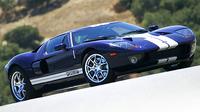Car Review: 2005 Ford GT
By Carey Russ
SEE ALSO: New Car Buyer's Guide for FordAt a recent Ford Company 2005 New Product preview I asked “what do I have to do to get a ride in the GT?'' Not, not the Mustang GT, the Ford GT - the limited-production tribute to the Ford GT40 that was victorious at the 24 Hours of LeMans in the late 1960s. ``Put your name on the list and wait'' was the answer, so I did that and tried a couple more cars until my turn came up.
Finally, just before it was time to go home, it was time to get into the GT. A little background is in order. In the early 1960s, Enzo Ferrari, in need of financing for his various racing teams, had some apparently-serious talks with Ford regarding Ford buying Ferrari. Or maybe he was just playing with the Americans, because the deal fell through at the last minute. Ford's visions of entering European endurance racing took a sudden detour, but, hey, if you can't buy `em, beat `em.
Ford embarked upon development of a car to compete in European-style endurance racing, with the goal of winning the prestigious 24 Hours race held at LeMans, France, which was essentially a Ferrari benefit in the early 1960s. The car was the GT40, so-called because of its height - 40 inches - and the fact that it ran in the GT Prototype class. It took a couple of years of expensive and frustrating development, but Ford finally met its goal in 1966. And the winning streak continued, at LeMans and elsewhere, until rules changes at the end of 1969 made them obsolete.
The GT40 was fabricated, in the manner of racing cars of its day, with a central monocoque chassis of riveted and welded sheet steel. Much of the chassis rigidity was due to the two wide torque boxes used both as door sills and fuel tanks. All GT40s had right-hand drive and a right-hand gearshift lever, which made entry and exit for the driver a bit tricky. As did the wide sills. They were race cars, so creature comforts - and space - were minimal. Yes, there were a few made for the street, and a number of replicas of varying degrees of fidelity to the originals, but none of those were much better in the accouterment department, either.
This Ford GT is most definitely not a GT40 replica, and that's a good thing for those well-heeled people who have bought one. First, the GT is best thought-of as a look-alike four-thirds scale tribute to the GT40 as it is considerably larger and built in a very different manner.
Although its proportions are close to those of the GT40, the GT is 18 inches longer, and four inches higher. It has a space frame made of aluminum extrusions, castings, and stampings, and is made for use on the street- and the odd track day or time trial. Its 3,500-lb curb is a thousand pounds more than that of the GT40 Mk II that won LeMans in 1966, but its 550-horsepower 5.4-liter supercharged dual overhead cam aluminum alloy V8 is comparable to or perhaps even stronger than the 7-liter pushrod stock car V8 in the Mk II.
This GT was the development car, which had been clocked at 207 mph in testing, almost exactly the same top speed as the GT40 MkII in LeMans trim. Journalists were not allowed to drive as it was privately-owned - by Steve Saleen. How'd he get the development car? Perk of the job - among his other interests, he is in charge of GT construction. And, hey, if it was my car I'd be more than a little hesitant about letting journalists drive it, too.
Although the GT, at 44 inches high, is pretty low, entry is surprisingly easy. As on the GT40, the doors are cut nearly halfway into the roof. And the GT is an American-spec left-hand drive, right-hand shift car, with the fuel tank in the central backbone tube. No dicey climbing over a wide sill with a gearshift lever waiting to impale the unwary.
The driver, a Ford PR representative, was about six-four and fit fine. How is it? Not exactly luxurious, but far above a race car in comfort. How fast? We tried to stay as legal as possible, but it still made the Saleen SC281 SC feel like an armor-plated Town Car. Sitting so low to the ground only enhances the effect of speed, acceleration, and deceleration. I can only hope that those lucky (and wealthy) enough to own a GT don't keep it in a hermetically-sealed collector's case but take it out and use it. A fine time trial car, with a great stereo, too - and I'm not talking about electronics, if you know what I mean.



